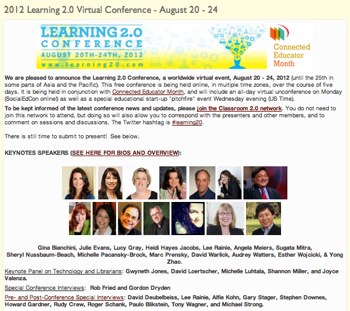 Several weeks ago Steve Hargadon invited me to deliver a keynote address for his Learning 2.0 Virtual conference, which he has been planning for Connected Educator month (August). I confess that I neglected to respond for some time, because, frankly, I do not enjoy these things and consider them a poor substitute to an actual face-to-face conference. It’s the old and old-fashioned teacher in me that feels that way. But, because I respect Steve enormously I finally agreed do a session, dreading its approach. However, I always, ALWAYS, end out enjoying the experience, feeling good about my contribution, and I’ve watched and learned from a number of the other presentations and keynote throughout the conference. As my friend, Peggy George, said,
Several weeks ago Steve Hargadon invited me to deliver a keynote address for his Learning 2.0 Virtual conference, which he has been planning for Connected Educator month (August). I confess that I neglected to respond for some time, because, frankly, I do not enjoy these things and consider them a poor substitute to an actual face-to-face conference. It’s the old and old-fashioned teacher in me that feels that way. But, because I respect Steve enormously I finally agreed do a session, dreading its approach. However, I always, ALWAYS, end out enjoying the experience, feeling good about my contribution, and I’ve watched and learned from a number of the other presentations and keynote throughout the conference. As my friend, Peggy George, said,
This is such an incredible opportunity for us to be able to learn and connect virtually wherever we are!
..and it was free.
Since I assembled my talk, “The Memory Lane of a 30-Year Connected Teacher and Learner,” specifically for this event, I did not have any online handouts, and since I ended out taking exactly my allotted hour and leaving no time for questions, I thought I would take this opportunity to scan through the chat archive and respond here to any questions or comments that strike a nerve.
First of all, this was not a “Here’s how you do this” sort of presentation nor did I tour through cool web sites or suggest cool ways to use iPads. There were and will be plenty of presentations that fill that niche. My uniqueness right now is my age and range of experiences, and so I reverted back to my Southern heritage and shared some stories “..about some of the critical and revelatory moments of (my) long career.” You can revisit my talk here, as Steve is archiving all (?) of the presentations.
First of all, I was impressed by the number of learning20 hash-tagged (#learning20) postings on Twitter that were not in english. In fact, I see now that some of the names in my chat archive included letters that are not among the 26 character Roman alphabet – more evidence of the increasing globalization of education.
| Here are some links posted during my talk:
|
One of the really cool things about these virtual events, and about being part of the backchannel at face-to-face events is when people share URLs related to what I am talking about – and often they are web pages, of which I was not aware. In a sense, the online handouts just happen. ..because learners are also teachers.
One point I’d like to double-click on is the WIRED magazine issue I’m reading on my iPad, the magazine’s first issue, published in 1993, and now available for the WIRED iPad app. I love scanning through these old magazines because of the advertisements, seeing the sorts of technologies that were emerging 20 years ago, how big they were, and how much they cost. There was a Sony GPS that gave you the coordinates of you current location at a cost of only $1,195 (USD). 20 years ago, that was fantastic. Imagine being able to know, at any time, your exact location in relation to the Equator and Prime Meridian. Fantastic! Yet, I just bought a Garmin app for my iPhone that operates exactly like the Garmin GPS that I drive with, and it only cost 99¢.
We are preparing our children for THE FANTASTIC.
Do we truly grok the implications of this?
I have to delight at the recognition several members of the audience registered for the Radio Shack Tandy computers I talked about and their further references to the Sinclair, TI-99, VIC-20 (I had one) and Atari 400 computers, machines that all helped to define personal computing today. It made me feel “not so old.” I guess I’ll be old when I have to explain what a cassette tape is to my audience 😉
In contrast, someone mentioned the current tech-du-jour, Arduino and Raspberry Pi – off-the-shelf computer circuit boards that people (“makers”) are using to create all sorts of intelligent objects. This is something I want to learn about and play with. Someone recommended the Raspberry Pi.
Another participant asked about the old computer magazines that featured BASIC programs that you could type into your Atari or VIC-20. “Compute!” was one of them and it was published out of Greensboro, North Carolina. Orson Scott Card worked for them at the time – and some of you know him as the author of “Ender’s Game,” one of the best science fiction books ever written.
I told the story of a librarian friend of mine, Cynthia Wilson, who, back in the ’80s got some at-risk 7th graders to write children’s books using Apple IIe computers and FrEdWriter, and then emailed them to first graders down the street using FrEdMail (There really needs to be a Wikipedia article about FrEdMail). The First graders read the books, illustrated the them, and then brought their prizes back up to the middle school where the 7th graders did a book signing. It’s a concept that has continued as the chat perked up at that point, with lots of ways that teachers and librarians are continuing to empower learners by making them authors. (see links above)
During several of my stories, which involved teachers and learners connecting to the real world, there was some conversation about teachers who are reluctant to allow their students to share their work outside of their classrooms. I believe that it comes from a lack of confidence, and this is not wholly our fault. It’s part of what I talked about at the end, how the empowerment that comes from “connected” teachers and learners has to come from somewhere, and that somewhere is the various social, political, and commercial interests who have traditionally enjoyed and employed that power – and have a need to exert more. I believe that causing communities to lose confidence in public education has been an explicit part of the school privatization movement that may well have begun with No Child Left Behind.
Someone commented, “Why can’t we have developers of apps working in our schools with our students on projects they are working on?” I think this is a fabulous idea, and I remember reading about a school in New York that hires game developers to work with teachers and learners. That has always seemed a brilliant thing to do. But I wonder if this “developer” needs to be an adult, or if it could be one of, or a team of students.
Again, I thoroughly enjoyed presenting to the conference, from my home office, and am actually getting accustomed to teaching to that little green light at the top of my laptop display that marks the position of the camera.
I also want to take this opportunity to thank Steve Hargadon for this and all of the “connections” that he creates and facilitates for educators around the world. All the wires and cables that circle our globe come to nothing if there is not a community of interest, and that community doesn’t happen without an architect. Thanks to Steve Hargadon for bringing us all together so many days of the year!
 While your students may not be writing bestsellers anytime soon, this may still interest some of your more literary students. HipType compile this data on the content, genre, and readers of books, and may just have created a formula (or at least a starting point), for a successful book. Of course in my opinion the best books are the classics written by those who loved writing and who didn’t set out to write a bestseller, but to each his own.
While your students may not be writing bestsellers anytime soon, this may still interest some of your more literary students. HipType compile this data on the content, genre, and readers of books, and may just have created a formula (or at least a starting point), for a successful book. Of course in my opinion the best books are the classics written by those who loved writing and who didn’t set out to write a bestseller, but to each his own.







 Several weeks ago
Several weeks ago 